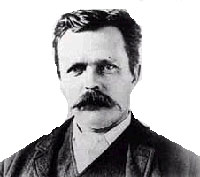- John Milne
Infobox Person
name = John Milne
caption = John Milne
birth_date = 1850
birth_place =Liverpool ,England
death_date =31 July 1913
death_place =Shide ,Isle of Wight ,England
other_names =
known_for = Foreign advisor to MeijiJapan
occupation = scientist, educator, foreign advisor to Japan
nationality =England John Milne (1850 –
31 July 1913 ["Who's Who 1914", p. xxiii] ) was the Britishgeologist and miningengineer who invented theseismograph .Biography
Milne was born in
Liverpool ,England and raised inRochdale andMilnrow inLancashire . [cite web|url=http://www.rochdaleobserver.co.uk/news/s/1021736_famous_scientists_on_road_to_name_wrangle |title=Famous scientists on road to name wrangle |date=2007-10-27|accessdate=2008-04-22|publisher=rochdaleobserver.co.uk|author=McKeegan, Alice] He was educated atKing's College and theRoyal School of Mines , afterwards working as a mining engineer inNewfoundland andLabrador . In 1874, he participated in a geological survey expedition to northwestArabia .Career in Japan (1875-1895)
Milne was hired by the
Meiji government of theEmpire of Japan as a foreign advisor and professor of mining and geology at theImperial College of Engineering inTokyo fromMarch 8 ,1876 , where he worked underHenry Dyer and withWilliam Edward Ayrton and John Perry. Partly from a sense of adventure and partly because he suffered fromseasickness , he traveled overland acrossSiberia taking three months to reach Tokyo. In 1880, SirJames Alfred Ewing , Thomas Gray and John Milne, all British scientists working in Japan, began to studyearthquake s following a very large tremor which struck the Yokohama area that year. They founded the Seismological Society of Japan and the society funded the invention of seismographs to detect and measure the strength of earthquakes. Although all three men worked as a team on the invention and use of seismographs, John Milne is generally credited with the invention of the horizontal pendulumseismograph in 1880. [Gregory Clancey. [http://books.google.com.sg/books?id=m0eUSUtm0iMC "Earthquake Nation: The Cultural Politics of Japanese Seismicity, 1868-1930"] (Berkeley: University of California Press, 2006).] Milne's instruments permitted him to detect different types of earthquake waves, and estimate velocities.Contributions to Anthropology
In addition to his work on
seismology , from 1882 John Milne was also contributing to the world ofanthropology . He helped develop theories on where the Ainu of northern Japan came from, and theories on the racial background of the prehistoric peoples of Japan in general. After having actually excavated for several years in theOmori shell mound , John Milne introduced the conception of the "Koropok-guru" race, racially linked with theInuit . The word "Koropok-guru" came from an Ainu word meaning “the man under the rhubarb,” i.e. a small person. An Ainu legend concerning the existence of such a people seems to have been first reported by Milne. However, Milne believed that only inHokkaidō were prehistoric sites of the "Koropok-guru" people. For northeastern Japan proper, he subscribed to the tradition which assigned prehistoric sites to the Ainu, who lived in pits and made stone implements and pottery. He considered the inhabitants of theKurile Islands ,Sakhalin and southernKamchatka to be of a different race, though possibly one related to the Koropok-guru. He anticipated the work of later scientists who in actual materials recovered recognized different prehistoric cultures for Hokkaidō and northeastern Japan. [Nishioka]Career in England (1895-1913)
After a fire on
February 17 ,1895 destroyed his home, observatory, library, and many of his instruments. Milne resigned his posts onJune 20 ,1895 and returned to England with his Japanese wife, settling atShide Hill House ,Shide , on theIsle of Wight , where he continued his seismographic studies. He was made a professor emeritus ofTokyo Imperial University .Milne persuaded the
Royal Society to fund 20 earthquake observatories around the world, equipped with his horizontal pendulumseismograph s. His network initially included seven in England, three inRussia , one inBritish Columbia , three on the east coast of theUnited States , and one inAntarctica , eventually growing to total 40 worldwide. These stations sent their 'station registers' to Milne, where the data formed the basis of Milne's researches. For the next 20 years, Milne’s seismological observatory was the world headquarters for earthquake seismology.In 1898, Milne (with
W. K. Burton ), published "Earthquakes and Other Earth Movements", which came to be regarded as a classic textbook on earthquakes.The need for international exchange of readings was soon recognized by Milne in his annual "Shide Circular Reports on Earthquakes" published from 1900 to 1912. This work was destined to develop in the
International Seismological Summary being set up immediately after theFirst World War .Milne died of
Bright's disease onJuly 31 ,1913 .Notes
References
* Gregory Clancey. [http://books.google.com.sg/books?id=m0eUSUtm0iMC "Earthquake Nation: The Cultural Politics of Japanese Seismicity, 1868-1930"] (Berkeley: University of California Press, 2006). Milne is a main character in this book.
* L.K. Herbert-Gustar and P.A. Nott published a biography of Milne "John Milne, Father of Modern Seismology" in 1980 ISBN 0-904404-34-X
* Paul Kabrna "John Milne - the Man who Mapped the Shaking Earth" ISBN 978-0-9555289-0-3 Published by Craven & Pendle Geological Society in March 2007.
* Nishioka, Hideo; W. Egbert Schenck. An Outline of Theories concerning the Prehistoric People of Japan. American Anthropologist © 1937 American Anthropological Association
* Robert Stonely. The History of the "International Seismological Summary", Geophysical Journal Research (1970), 20, 343-349External links
* [http://www.lib.u-tokyo.ac.jp/tenjikai/tenjikai97/milne.html John Milne on Tokyo University library website] (Japanese, includes photographs)
* [http://inventors.about.com/library/inventors/bljohnmilne.htm Earthquakes - A Seismograph Measures Earthquakes ] at inventors.about.com
* [http://www.cpgs.org.uk John Milne the man who mapped the shaking earth]
* http://links.jstor.org/sici?sici=0002-7294%28193701%2F03%292%3A39%3A1%3C23%3AAOOTCT%3E2.0.CO%3B2-L
Wikimedia Foundation. 2010.
